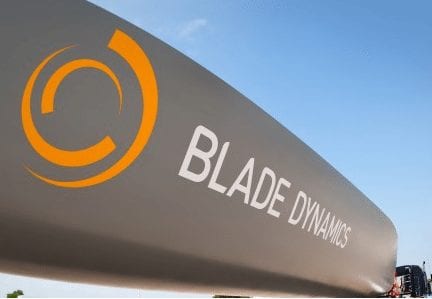The UK Energy Technologies Institute (ETI) has appointed UK wind turbine developer Blade Dynamics to develop and demonstrate the technologies for constructing what would most likely end up being the world’s longest wind turbine blades.
The wind turbine blades would measure in at between 80 and 100 metres in length, compared to more traditional offshore blades which only measure in at 60 to 75 metres in length. These new blade types are hoped to be used on the next generation of large offshore wind turbines that are currently under development, which will generate a capacity of 8 to 10 megawatts, up from the 5 to 6 megawatts of capacity currently in play in existing offshore turbines.
The new blades will be constructed incorporating carbon fibre rather than conventional fibre glass, and are constructed by means of a new design and manufacturing process which see the wind turbine blades assembled from smaller, more accurate and easily manufactured component pieces. This, instead of the common large and expensive full-length mouldings.
“We have worked hard on the design of this blade technology for a number of years now,” said David Cripps, Senior Technical Manager, from Blade Dynamics. “Financial backing from the ETI for this project allows deployment on ultra-large turbines far sooner than would otherwise have been possible and as a result of this project we will be hiring new engineers and technologists to make this possible.”
The project is expected to see the blades manufactured and in a position to begin production by late 2014, which, as Cripps mentioned, brings this innovation into play much sooner than would have been expected. Design and innovation on this level desperately deserves the financial backing necessary to expedite production in an effort to push renewable energy industries into a leading electricity generating role.
The blades will weigh up to 40% less than the more traditional, glass-fibre blades and will help reduce the cost of the energy produced by the blades by way of cutting on weight and cost savings.
“Offshore wind has the potential to be a much larger contributor to the UK energy system if today’s costs can be significantly reduced,” said Paul Trinick, Offshore Wind Project Manager at the ETI. “Investing in this project to develop larger, more efficient blades is a key step for the whole industry in paving the way for more efficient turbines, which will in turn help bring the costs of generating electricity down.”
The £15.5 million project will see the ETI — a public-private partnership between BP, Caterpillar, EDF, E.ON, Rolls-Royce, Shell, and the UK Government — become an equity investor in the Isle of Wight-based developer, and represents the second time in the past 12 months that the ETI has undertaken a private equity investment in a UK SME.
One can now only hope that other firms and investors will take note of the sort of innovation that exists across all the renewable energy industries and act accordingly. And for a massive photo of one of the new blades, check out this photo and be prepared to be amazed.
And let’s not forget the other innovations in wind turbine technology. Just last October Siemens started testing the world’s largest wind turbine rotor; December saw the first ever floating wind turbine being tested in the US; and in October Uprise Energy unveiled its new portable 50kW wind turbine.











